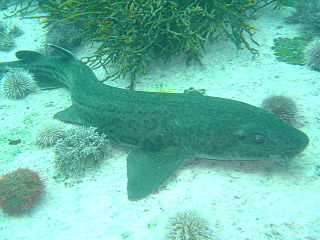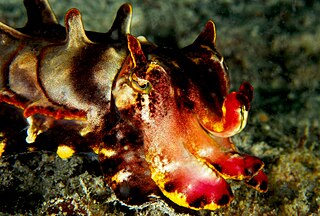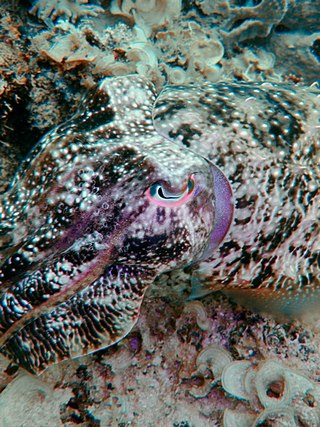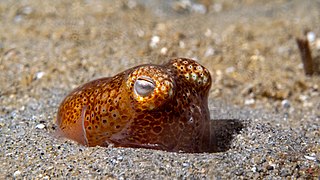
A cephalopod is any member of the molluscan class Cephalopoda such as a squid, octopus, cuttlefish, or nautilus. These exclusively marine animals are characterized by bilateral body symmetry, a prominent head, and a set of arms or tentacles modified from the primitive molluscan foot. Fishers sometimes call cephalopods "inkfish", referring to their common ability to squirt ink. The study of cephalopods is a branch of malacology known as teuthology.

The California two-spot octopus, often simply called a "bimac", is an octopus species native to many parts of the Pacific Ocean including the coast of California. One can identify the species by the circular blue eyespots on each side of its head. Bimacs usually live to be about two years old. They are closely related to Verrill's two-spot octopus. In 2015, O. bimaculoides became the first octopus to have a fully sequenced genome.

The paintpot cuttlefish is a small, poorly researched species of cuttlefish found in the Indo-Pacific, between Japan and Hong Kong. It is one of the two species classified in the genus Metasepia. Metasepia cuttlefish are characterized by their small, thick, diamond-shaped cuttlebone, and distinctive body coloration.

Doryteuthis opalescens, the opalescent inshore squid or market squid, is a small species of squid in the family Loliginidae. It is a myopsid squid, a near shore group with corneas over their eyes. The species is found in the eastern Pacific Ocean from Baja California, Mexico to Alaska, United States, and as an inshore squid can be found within a range of 200 miles (320 km) off the coast.

The leopard catshark is a species of catshark, and part of the family Scyliorhinidae, endemic to the coastal waters of South Africa. Abundant in inshore waters under 20 m (66 ft) deep, this bottom-dweller favors rocky reefs, kelp beds, and sandy flats. Growing to a length of 84 cm (33 in), the leopard catshark has a stout body with two dorsal fins placed well back, and a short head and tail. It is extremely variable in color and pattern, with individuals ranging from almost white to black and covered by diverse patterns of black spots, blotches, rosettes, and/or lines. The color pattern changes with age and some forms seem to be location-specific, suggesting the presence of multiple distinct, local populations. In the past, some of the more distinct color forms have been described as different species.

Metasepia pfefferi, also known as the flamboyant cuttlefish, is a species of cuttlefish occurring in tropical Indo-Pacific waters off northern Australia, southern New Guinea, as well as numerous islands of the Philippines, Indonesia and Malaysia.

Sepia latimanus, also known as the broadclub cuttlefish, is widely distributed from the Andaman Sea, east to Fiji, and south to northern Australia. It is the most common cuttlefish species on coral reefs, living at a depth of up to 30 m.

The common cuttlefish or European common cuttlefish is one of the largest and best-known cuttlefish species. They are a migratory species that spend the summer and spring inshore for spawning and then move to depths of 100–200 metres (330–660 ft) during autumn and winter. They grow to 49 centimetres (19 in) in mantle length and 4 kilograms (8.8 lb) in weight. Animals from subtropical seas are smaller and rarely exceed 30 centimetres (12 in) in mantle length.

The pharaoh cuttlefish is a large cuttlefish species, growing to 42 cm in mantle length and 5 kg in weight.

Sepia mestus, also known as the reaper cuttlefish or red cuttlefish, is a species of cuttlefish native to the southwestern Pacific Ocean, specifically Escape Reef off Queensland to Murrays Beach off Jervis Bay. Reports of this species from China and Vietnam are now known to be misidentifications. S. mestus lives at a depth of between 0 and 22 m.
Euprymna hyllebergi, the Thai bobtail squid is a species of squid belonging to the family Sepiolidae and is native to the eastern Indian Ocean. It is commonly found in the Andaman Sea of Thailand and in the Gulf of Thailand. E. hyllebergi can grow up to 35mm in mantle length and can be found in depths as low as 74m. The Thai bobtail squid is covered in chromatophores, which are pigmented cells that can expand or contract and are used to camouflage the squid. The normal lifespan of the Thai bobtail squid is between 92 and 122 days for males and between 80 and 113 days for females.

Spawn is the eggs and sperm released or deposited into water by aquatic animals. As a verb, to spawn refers to the process of freely releasing eggs and sperm into a body of water ; the physical act is known as spawning. The vast majority of aquatic and amphibious animals reproduce through spawning. These include the following groups:

Cuttlefish, or cuttles, are marine molluscs of the suborder Sepiina. They belong to the class Cephalopoda which also includes squid, octopuses, and nautiluses. Cuttlefish have a unique internal shell, the cuttlebone, which is used for control of buoyancy.

Sepioteuthis lessoniana, commonly known as the bigfin reef squid, tiger squid, glitter squid, oval squid, or northern calamari, is a species of loliginid squid. It is one of the three currently recognized species belonging to the genus Sepioteuthis. Studies in 1993, however, have indicated that bigfin reef squids may comprise a cryptic species complex. The species is likely to include several very similar and closely related species.

Sepia elegans, the elegant cuttlefish, is a species of cuttlefish in the family Sepiidae from the eastern Atlantic Ocean and the Mediterranean Sea. It is an important species for fisheries in some parts of the Mediterranean where its population may have suffered from overfishing.

The dwarf cuttlefish (Sepia bandensis), also known as the stumpy-spined cuttlefish, is a species of cuttlefish native to the shallow coastal waters of the Central Indo-Pacific. The holotype of the species was collected from Banda Neira, Indonesia. It is common in coral reef and sandy coast habitats, usually in association with sea cucumbers and sea stars. Sepia baxteri and Sepia bartletti are possible synonyms.

Wunderpus photogenicus, the wunderpus octopus, is a small-bodied species of octopus with distinct white and rusty brown coloration. 'Wunderpus' from German "wunder" meaning 'marvel or wonder'.

Octopus bimaculatus, commonly referred to as Verrill's two-spot octopus, is a similar species to the California two-spot octopus, which it is often mistaken for. The two can be distinguished by the difference in the blue and black chain-like pattern of the ocelli. O. bimaculatus hunt and feed on a diverse number of benthic organisms that also reside off the coast of Southern California. Once the octopus reaches sexual maturity, it shortly dies after mating, which is approximately 12–18 months after hatching. Embryonic development tends to be rapid due to this short lifespan of these organisms.

Sepia lycidas, commonly known as the kisslip cuttlefish, is a species of cuttlefish within the genus Sepia. They are also classified under the family Sepiidae, which encompasses some of the most commonly known and recognized cuttlefish. Phylogenetically, this species of cuttlefish is most closely related to Sepia aculeata, Sepia esculenta, and Sepia pharaonis. This species is typically reddish brown to purple in color, with patches and stripes present on their dorsal mantle. On average, they grow to be about 38 cm in length and weigh 5 kg at maximum. The kisslip cuttlefish can be found mainly within the Indo-West Pacific, at depths ranging from 15–100 meters. Additionally, this species exhibits many diverse, complex reproductive behaviors; for example, courting, mating displays, and mate competition. Other interesting behaviors includes their feeding and hunting methods, which entails turning towards a preferred direction to "jump on" and engulf their prey of small fish and crustaceans. Sepia lycidas has many human uses and is important in the economy of many Southeast Asian countries, especially since they are often eaten for their high nutritional value. They are also currently being studied as an alternative source of collagen for human use, since their thick outer skin contain high levels of collagen that goes to waste when they are eaten or caught as bycatch.

Sepiadarium austrinum, the southern bottletail squid, is a species of cuttlefish in the genus Sepiadarium. It was first described by S. Stillman Berry in 1921 based on a specimen found in St. Vincent Bay in South Australia.



















